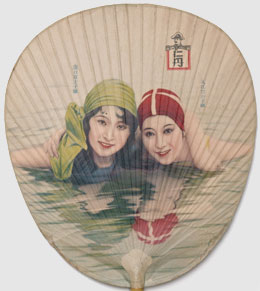Taisho Chic
dal 13/9/2005 al 23/12/2005
Segnalato da
13/9/2005
Taisho Chic
Berkeley Art Museum and Pacific Film Archive BAM/PFA, Berkeley
Japanese Modernity, Nostalgia, and Deco. The Taisho era was a brief but dynamic period in Japan's modern development that is often described as a Japanese version of the Roaring Twenties. Over sixty scroll paintings, folding screens, woodblock prints, kimono, and other works of decorative art. The show has a special focus on art and objects associated with women.

Japanese Modernity, Nostalgia, and Deco
The Taisho era was a brief but dynamic period in Japan's modern development that is often described as a Japanese version of the Roaring Twenties. Officially it lasted from 1912 to 1926, the reign of the Emperor Taisho, but the phrase “Taisho culture†evokes a society in transition in the twenties and early thirties, when Western Jazz Age mores and styles bumped up against traditional Japanese values of harmony and tranquility. During this period, as Japan was becoming an international power, the gap, born in the Meiji era, between a traditional agriculturally based population and the modern industrial sector widened.
This fall in the BAM galleries, over sixty scroll paintings, folding screens, woodblock prints, kimono, and other works of decorative art illuminate the broad spectrum of Taisho culture. Guest curated by Kendall H. Brown, Taisho Chic has a special focus on art and objects associated with women, whose fashions, behavior, and changing roles exemplify the simultaneous clash and embrace of modernity and tradition in Japan in the twenties and thirties. The modern girl (modan gaaru, or moga for short) was the subject of much of the art of the period. These young women, the Japanese equivalent of flappers, were office workers, shopgirls, or waitresses and therefore had a measure of economic independence from their families. Cafes, dance halls, and nightclubs were public spaces most associated with moga and modern life. Tokyo was still being rebuilt following the devastating earthquake of 1923, and many young sophisticates flocked to Shanghai for its cosmopolitan nightlife. A print by Koka Yamamura, New Carleton Dancers, Shanghai (1924), depicts two stylish women in Western dress seated at a table in a nightclub while several couples dance in the background.
In general, painters identified themselves with either yoga painting, characterized by the use of Western materials such as oil and watercolor, and with progress; or nihonga painting, associated with the preservation of traditional materials, formats, and modes, and subjects such as landscape, bird-and-flower, and the figure. Many painters in both strands specialized in bijinga, or the representation of women. In nihonga bijin artist Shuho Yamakawa's 1927 woodblock Autumn, the season is suggested by the subject's russet-colored cloak and the falling orange leaves in the background. Nonetheless, the sitter is indeed modern, as evidenced by her hairstyle—rajio-maki, or radio rolls or coils over the ears, meant to resemble headphones worn by radio announcers, considered a glamorous job. Despite the nod to modernity, however, she doesn't threaten traditional notions of womanhood as fashionable and allied with nature and passivity. Conversely, Tipsy (1930), by Kiyoshi Kobayakawa, depicts the epitome of the moga as a sex symbol, alone at a nightclub table with cigarette and cocktail. Her hair is bobbed, her face made up, and her dress daringly low cut and sleeveless.
Many paintings in the show exemplify the cultural hybridity of the period, none more elegantly than Daizaburo Nakamura's two-panel screen Woman (1930). The model was the famous film actress Takako Irie, here dressed in a red kimono and reclining on a Western chaise in a nod to Manet's Olympia. (The link to cinema is found throughout the Taisho period. Takako Irie stars in Mizoguchi's The Water Magician, one of the films featured in a major PFA series that begins in November in association with the exhibition.) Another charming example of West meets East is the screen Three Sisters (1936) by Shuho Yamakawa, in which the demure kimono-clad daughters of a successful industrialist pose in and in front of their luxurious touring automobile.
The kimono featured in the exhibition also reflect the influence of the West, while still retaining traditional references. In one, the pattern is based on the ancient chrysanthemum motif but the flowers are enlarged to the point of losing their identity in the overall repetitive graphic scheme. Decorative objects use art deco design motifs, seen in a delicate set of ruby-overlay glass cups and saucers and an aluminum condiment set and tray.
Long overlooked by scholars, the Taisho era is now being seen as a significant artistic period as well as cultural phenomenon, largely thanks to the connoisseurship of the art dealer Patricia Salmon, from whom the bulk of the collection on view was purchased by the Honolulu Academy of Arts in 1987. Visitors are invited to explore the cultural and artistic issues raised by the exhibition in our public programs; in the film series beginning in November at PFA (details available on this site in late October); and in a related exhibition in our Asian Galleries, Meiji à la Mode.
Constance Lewallen
Senior Curator for Exhibitions
Taisho Chic Fashion Show and Party: October 25, 2005
Taisho Chic has been organized by the Honolulu Academy of Arts.
This exhibition has been made possible by support from the Hawai'i State Foundation on Culture and the Arts.
The Berkeley presentation of Taisho Chic has been supported by the Consortium for the Arts and The Townsend Center for the Humanities at UC Berkeley.
Exclusive Media Sponsor: Classical 102.1 KDFC
BAM/PFA
2626 Bancroft Way
Berkeley



